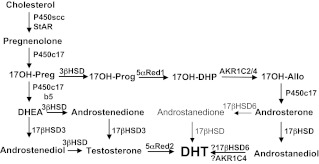Fig. 1.
The pathways of androgen biosynthesis. The classic pathway and the alternative “backdoor pathway” are shown. The classic pathway proceeds from 17OH-Preg to DHEA, to androstenedione or androstenediol to testosterone in the testis, and thence to DHT in genital skin. The backdoor pathway proceeds from 17OH-Preg to 17OH-Prog, 17OH-DHP, 17OH-Allo, androsterone, androstanediol, and thence to DHT, all in the testis. The enzymes and cofactors shown in the classic pathway are: P450scc (cholesterol side-chain cleavage enzyme), StAR (steroidogenic acute regulatory protein), P450c17 (17α-hydroxylase/17,20-lyase), 3β-HSD (3β-hydroxysteroid dehydrogenase, type 2), cytochrome b5, 17β-HSD3 (17β-hydroxysteroid dehydrogenase, type 3), and 5αR2 (5α-reductase, type 2). The alternative pathway is characterized by the presence of three additional enzymes: 5αR1 (5α-reductase, type 1), reductive 3α-HSD (AKR1C2/4), and oxidative 3α-HSD (17β-HSD6, also known as RoDH and/or AKR1C4). Steroid names include: 17OH-Preg, 17-hydroxypregnenolone; 17OH-Prog, 17-hydroxyprogesterone; 17OH-DHP, 17-hydroxydihydroprogesterone (5α-pregnan-17α-ol-3,20-dione); 17OH-Allo, 17-hydroxy-allopregnanolone (5α-pregnan-3α,17α-diol-20-one); androstenediol, androsta-5-ene-3β,17β-diol; and androstanediol, 5α-androstane-3α,17β-diol.

